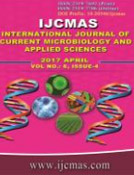


 National Academy of Agricultural Sciences (NAAS)
National Academy of Agricultural Sciences (NAAS)

|
PRINT ISSN : 2319-7692
Online ISSN : 2319-7706 Issues : 12 per year Publisher : Excellent Publishers Email : editorijcmas@gmail.com / submit@ijcmas.com Editor-in-chief: Dr.M.Prakash Index Copernicus ICV 2018: 95.39 NAAS RATING 2020: 5.38 |
Soil quality assessment is of paramount importance to know the appropriate management practices to be adopted for sustainable crop production. Sustainability of intensive agriculture system is intimately linked to maintenance of soil health. Present study was undertaken to investigate the impact of intensive cultivation on soil health under polyhouses located in Bilaspur, Solan and Sirmaur districts of Himachal Pradesh. Studies reveal that the bulk density ranged from 1.09 to 1.13 Mg m-3. The particle density varied between 2.25 to 2.31 Mg m-3, whereas the porosity ranged from 49.47 to 51.09 per cent. The CEC values fell in the range of 14.70 to 15.00 meq./100g. The soil reaction was noted to be neutral (7.08 to 7.34) and EC values were in safe limits (<0.8 dS m-1). The organic carbon content varied from 1.76 to 2.00 per cent. The available N, P and K ranged from 246.1 to 264.8, 49.5 to 61.9 and 587.1 to 682.5 kg ha-1, respectively. The exchangeable Ca and Mg were found to be adequate and sulphur content (15.21 to 16.99 mg kg-1) was found moderate in the soils. Available Zn, Fe, Cu and Mn were medium to high in availability, both under polyhouse and open field conditions. The microbial biomass ranged from 322.65 to 385.343 µg g-1, falling under medium range for categorizing soil health. In light of the soil health index values 36.7, 46.7 and 16.6 per cent of samples were categorized under the very high, high and medium soil health, respectively under polyhouse conditions. Such values for open field condition were noted to be 10, 70 and 20 per cent, respectively. Soil health was found to be affected by the management practices adopted by the farmers and the degree of manure and fertilizer usage over a period of time considerably.
 |
 |
 |
 |
 |